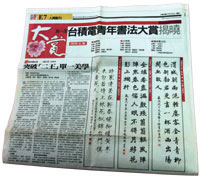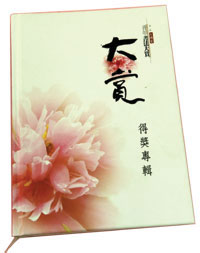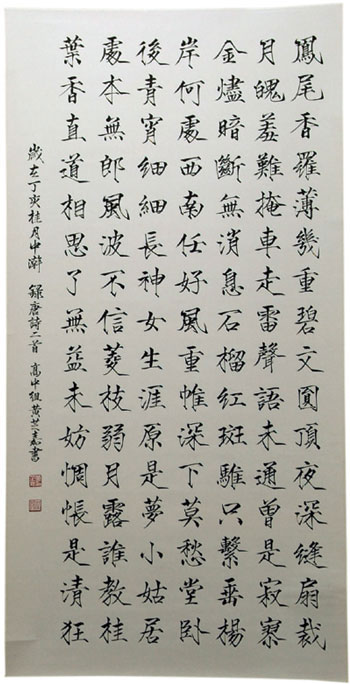A style of her own / 以書法開創自我風格
A style of her own
Inside Chi-Chia Huang's world of Calligraphy
◎Text by Hsin-Yi Peng
◎Photos by Jessica Lin and Chung-Hui Pao
.jpg) Calligraphy is a traditional art form that has a prominent presence in Chinese history. It is not only appreciated for the aesthetic value, but also its practical use. During the thousands of years of its existence, calligraphy has evolved and progressed, there are many different styles and scripts. Famous calligraphers' names are respected and known not only by their contemporary peers, but also by the generations after their time. Their manuscripts have been used as practice models by calligraphy enthusiasts.
Calligraphy is a traditional art form that has a prominent presence in Chinese history. It is not only appreciated for the aesthetic value, but also its practical use. During the thousands of years of its existence, calligraphy has evolved and progressed, there are many different styles and scripts. Famous calligraphers' names are respected and known not only by their contemporary peers, but also by the generations after their time. Their manuscripts have been used as practice models by calligraphy enthusiasts.
In this time and age when writing is done mostly through the use of keyboards, and documents are digitized, preserving the classic art of writing calligraphy with a brush pen has become a priority in Chinese society. Even though calligraphy has been in use for thousands of years, it is not taken for granted. In Taiwan, calligraphy courses begin in elementary school and are taught up to junior high school. Such effort has produced a good number of young and outstanding calligraphers. In 2008, Taiwan Semiconductor Manufacturing Company Limited held the first "TSMC Youth Calligraphy Championship" and many of the participants submitted very sophisticated calligraphy works. The judges were especially impressed by the first prize winner of the "Standard/Clerical script" category with her presentation in "Slender Gold" script.
 Chi-Chia Huang is a senior at the Kaohsiung Municipal Haiching Vocational High School of Technology and Commerce. Tall and slender, the demure teen age girl somewhat resembles the form of her calligraphy. She used to study music, but when her father took her to a calligraphy master when she was in the third grade, she found her true passion. Chi-Chia began to take home awards from fourth grade on. The unique "Yi-Mo Shen" script (created by contemporary calligraphy master, Yi-Mo Shen) she practiced at the time, made her stand out in every competition she participated in, and won awards time and again.
Chi-Chia Huang is a senior at the Kaohsiung Municipal Haiching Vocational High School of Technology and Commerce. Tall and slender, the demure teen age girl somewhat resembles the form of her calligraphy. She used to study music, but when her father took her to a calligraphy master when she was in the third grade, she found her true passion. Chi-Chia began to take home awards from fourth grade on. The unique "Yi-Mo Shen" script (created by contemporary calligraphy master, Yi-Mo Shen) she practiced at the time, made her stand out in every competition she participated in, and won awards time and again.
Chi-Chia said, most people practiced the "Standard script" when they first started writing calligraphy. However, there are actually many different variations of styles and writing schools that are derived from the Standard script. Slender Gold is one variation of the Standard script. It was created by Emperor Huizong of Song Dynasty. It has a distinctive character which separates this unique script from the rest, but few people currently practice it. Slender Gold features thin strokes that carry much strength to construct graceful and elegant character form. Chi-Chia is very fond of this Script and she believes it was because its style echoes with her own personality, thus she writes best in the Slender Gold script.
 Calligraphy work is a faithful reflection of the calligrapher's mood and state of mind. Chi-chia practices her calligraphy for more than two hours on a daily basis, except for days when she has to study for major exams. She said on a good day, she could go on for more than two or even three hours without tiring. When she is not in a good mood, practicing calligraphy helps to calm her down.
Calligraphy work is a faithful reflection of the calligrapher's mood and state of mind. Chi-chia practices her calligraphy for more than two hours on a daily basis, except for days when she has to study for major exams. She said on a good day, she could go on for more than two or even three hours without tiring. When she is not in a good mood, practicing calligraphy helps to calm her down.
That is not the only benefit of practicing calligraphy. Because most of the practice models were extracted from manuscripts of classic Chinese literature, it is very easy for Chi-Chia to follow the classic Chinese courses at school. Besides, calligraphy is an art form that pays tribute to the harmony of forms and structures, and because of that, Chi-Chia has developed a good eye for aesthetics. Chi-Chia is currently studying in the department of business and commerce, but she is considering focusing her future studies in art.
In the future, Chi-Chia hopes to be able to write in many more different scripts, especially the semi-cursive and cursive scripts, the two styles that focus not only to create the individual forms of each character, but the energy and flow of the entire piece. For people who are interested in learning calligraphy, Chi-Chia's words of advice are that they should learn from a qualified master to properly learn how to write each stroke, and to write each character in proper stroke order. One would then really learn to appreciate the depth of calligraphy and the pleasure of writing it.
以書法開創自我風格
黃芝嘉的書法世界
 ◎文/林昀熹
◎文/林昀熹
◎攝影/林昀熹.鮑忠暉
書法是中國傳統藝術歷史久遠,兼具實用與美學價值,數千年來不但因時代演變而衍生出變化多端的字體樣貌與諸多流派,著名的書法家也受到當代與後世推崇,其書法作品更是學習者臨帖的對象。
尤其是在書寫已普遍鍵盤化、數位化的今天,使用毛筆書寫的古典書法,更成為華人社會積極保存的傳統藝術,即使已有數千年歷史,書法仍是台灣中小學推廣的課程之一,因此也不乏年輕卻表現優秀的書法作者。2008年「第一屆台積電青年書法大賞」中就出現許多佳作,其中獲得楷隸組首獎的作品,更以瘦金體令所有評審為之驚豔。
寫出這幅得獎作品的,是目前就讀高雄市海青工商綜合高中三年級的黃芝嘉同學。身形高 、性格文靜的黃芝嘉,頗有她擅長的瘦金體風格;雖然也曾學習音樂,但自從小學三年級父親帶她拜師學習書法開始,芝嘉發現自己對書法更有興趣,從小學四年級開始就不斷贏得各種獎項,尤其是從小時候練的「沈尹默體」(沈尹默為現代書法家)改練瘦金體後,特殊的風格讓她獲獎頻率更為增加。
芝嘉說,一般書法學習者的入門字體就是楷書,而楷書又有多家不同風格與流派,由宋徽宗所創的瘦金體,就是楷書中自成一格且現在較少人寫的一種,而這種字體的筆跡瘦中有勁,形貌飄逸具詩意,芝嘉認為,也許是較接近自己的個性,因此寫起來也較得心應手。
書法字體能反映書寫者當時的心境。除非遇到重要的大考,芝嘉每天都固定練字兩小時以上,她表示,狀況好的時候,寫兩、三個小時都不覺得累,芝嘉說心情不好時,練習書法也會使她整個人較為平靜。
練書法的好處還不止於此,由於書法中留有許多古代流傳下來的規範,因此在上國文課學習古文時,芝嘉很快就可以進入狀況。此外,書法的美學要求講究整體結構與造型,也奠定了美學基礎。因此,雖然目前芝嘉唸的是商業類學科,日後她也考慮朝藝術發展。
未來芝嘉希望可以多學些不同的字體,尤其想要挑戰行書與草書,習得如何在行雲流水的運筆中營造出整體氣勢。而對於書法有興趣的朋友,黃芝嘉也建議要找老師指導,才能學會正確的筆順及各種筆劃寫法,以深刻體會書法的奧妙。